Packraft Day 4 - A Foolish Departure
Wednesday, May 15
Packraft day 4. Today we'd definitely be reaching the Stevens Canyon / Coyote Gulch area, which was only about seven-ish river miles ahead of us. Depending on the whether conditions on the river improved relative to yesterday (flow, obstacles, etc), we could possibly even be floating past the scenic wonder of Stevens arch by lunchtime. And... did that water in the river here this morning look just a bit higher than yesterday? We thought maybe it did. Good omen.
The glue repair on Tony-the-Tiger's battered bottom looked pretty good, and the Hatkos set about carefully taping over any and all potential problem areas.
Like clockwork, we were again ready almost exactly fifteen minutes late. It had rained again the night before, this time for long enough to create a little puddle in the overturned Tony-the-tiger, but standing now in the river at 8:15 a.m., the sky overhead was again clear and calm.
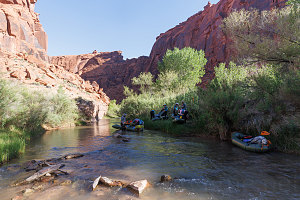
Ready to set off from Fools
Off we went from our Fools Canyon campsite, heading south downstream on the Escalante River. And like yesterday, we initially encountered a rough bit where floating passage was difficult, and then things eased off for a while.
As usual, Chris (Waddington), one of our more experienced paddlers, took a bit longer to get ready. Confident in his speed and abilities, he encouraged us to depart ahead of him. With his assurance that he would catch up, we set off down the river, relishing the tranquil beauty of the canyon. True to his word, Chris eventually appeared on the horizon, expertly navigating the river and rejoining the group with ease. His impressive paddling skills ensured we all stayed on track and enjoyed another memorable day on the water.
Our overall group's skill with negotiating river obstacles and sniffing out the best channels and paths had grown yet again, and was now leaps and bounds better relative to that first (admittedly now piddly rapid). We had all become quite a bit better at judging when and how to turn our watercraft in advance of sharp turns, and even how to do some reasonably fancy maneuvering mid-rapid. Still, it was more tiring work than one would casually imagine. But fun.
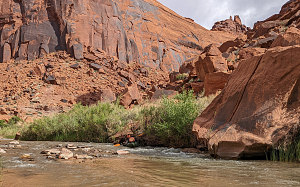
courtesy JInnes
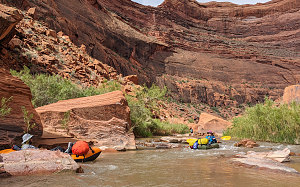
courtesy BConnell
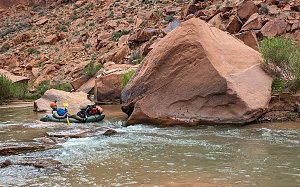
courtesy JInnes
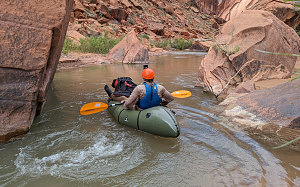
courtesy JInnes
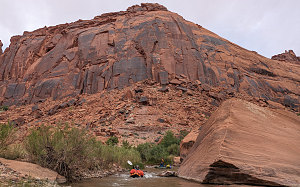
courtesy BConnell
Through a little pour-through
It's all about maneuvering
After a bit, we noticed that Chris (Waddington) had started to lag behind, which was unusual for him. After some waiting by the rest of the group, he came into view, accompanied by Gino. We learned that his raft seemed to be leaking, and he had had to repeatedly stop to add some air. This was concerning, of course, since not only was such a problem going to slow our progress, but it may end up being a safety problem on the wide, deep waters of Lake Powell, where one might not always be able to hop out and add a few breaths of air.
We stopped to do a more thorough investigation, and it was discovered that the leak appeared to be coming from the main air valve of the packraft itself - not from any abrasion or puncture of the packraft's body. It appeared as if a gasket was either damaged or not seated properly. Fortunately, the repair kits contained spare gaskets and Gino and Chris W managed to install and proof out a new gasket, and the problem seemed to be fixed.
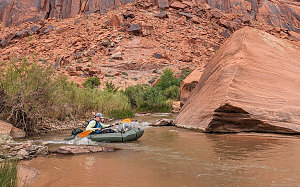
courtesy BConnell
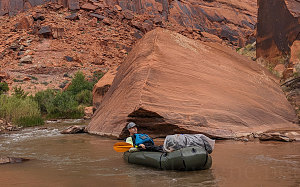
courtesy BConnell

courtesy JInnes
With Mr. Waddington's valve problems sorted, our overall speed increased a fair bit. It seemed as if the boulder chokes and the frequency of rapids was starting to ease off, too, and combined with our collectively increased level of skill at negotiating rapids, we made pretty decent time. It started to feel like we might actually make our noontime goal of reaching Stevens Arch.
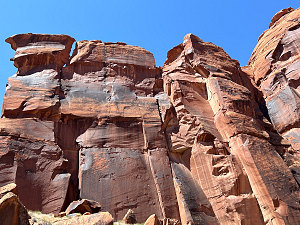
courtesy SWard
Jenn on the Lower Escalante
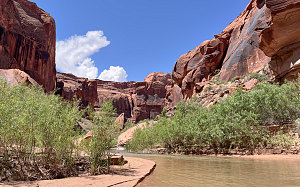
courtesy GBrancatelli
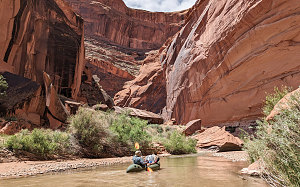
courtesy BConnell
Layer upon layer of Grandeur
We started to approach the environs of Stevens Arch and Coyote Gulch. The walls above us soared higher and overhanged in grand arches like nowhere before this point. Immense and grand and awe-inspiring. Turn after turn, we encountered more amazing canyon scenery - but no Stevens Arch. Finally... at about 1:30pm, we rounded yet another corner and spotted a large open window, high, high up on a big soaring fin of Wingate Sandstone: Stevens Arch.

courtesy BConnell

courtesy SWard
Ok, so not exactly noontime (it was past 1:30pm) but still close enough to the general vicinity of lunchtime to call it lunchtime. A sandbar in the river adjacent to the mouth of Stevens Canyon was a convenient spot to beach the packrafts, and we stopped to have our lunch. The Hatkos climbed up to eat at a slickrock vantage point of Stevens Arch, and the rest of us scattered about the area to do the same.
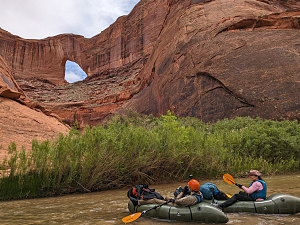
courtesy AWilcox

courtesy JInnes

courtesy GBrancatelli
Overhead, what had been a clear and sunny sky -- with hot and still conditions -- had started to change. High clouds started to drift in, at first only half-obscuring the sun. But then thicker clouds rolled in and the breeze started to pick up. Were we in for some inclement weather? The forecast a few days before had indeed mentioned a bit of mid-day instability. Fortunately, nothing heavy or serious was in the forecast.
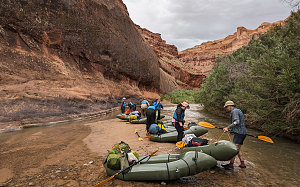
courtesy BConnell
Post-lunch departure
With our late lunch now finished, we headed off again under increasingly gloomy skies. Soon we heard an actual rumble of thunder, and experienced a few pitter-pattery raindrops. Overhead the clouds had developed that complex texture that usually signals atmospheric turbulence and energy.
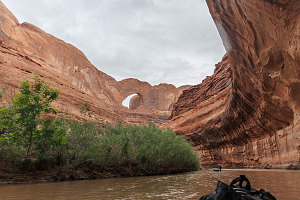
Stevens Arch from south
A light rain started to fall, whipped about by gusty winds. One or two more cracks of thunder were heard but they didn't seem to be that close to us. It wasn't a heavy rain, and overall I was not worried about flash flood danger, especially on this section of the Escalante, which had wide banks that would have allowed egress (brushy egress, but still egress) from the river to safe ground, if necessary.
Shortly before the confluence with Coyote Gulch, and in view of Stevens Arch from the south, we came across a length of rapid, perhaps forty or fifty feet long. The river's flow here had been concentrated far to the left, hard against the left-hand bank. It was essentially a long, six-foot wide linear chute of water. I enjoyed these sorts of rapids because as long as you were lined up with them, they were easy to run and you could actually gain some pretty decent speed going down them.
Because the flow was hard against the bank, riverside vegetation and branches overhung the flow, perhaps three or four feet above the water. We had frequently encountered this sort of thing, and it was frequently a challenge to make your way along without having a branch slap you in the face or threaten to poke your packraft. Usually we'd make a little pole-off on the bank to keep us from getting too close in, or leaning back to avoid branches in the face.
Anyway, as I was smoothly negotiating down this section, a branch of just the right shape and size snagged my GoPro Hero9, which for the past few days had been mounted (via a glued mount) on a helmet Gino had lent me. I felt the Gopro get stuck, and simultaneously my head being pulled back, hard, to the point where I started to get pulled backward out of my raft. And then... crack. Instantly I knew what had happened. I swore loudly, and my hand flew up to the top of the helmet, but it was too late - the GoPro's mount had snapped off and it and the GoPro were gone.
As quickly as I could, I jumped out of the raft and dragged it to the opposite bank, and then rushed back to the spot where it had snapped off. I had a sinking feeling in my stomach, knowing that finding the GoPro was going to be a long shot. The river's flow was fairly rapid here, and the silty nature of the water meant it was completely opaque. I frantically started feeling around in my feet at the rough location where I had lost it.
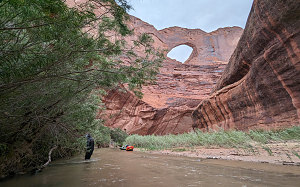
courtesy BConnell

courtesy JInnes
The Hatkos had seen all of this go down, and soon were on scene to help me search. We spent the next ten minutes futilely feeling around, but to no avail. I walked down to the end of the rapid section, where the river's flow slowed and entered a bit of a pool area, and looked and felt around some more. I couldn't see more than a fraction of an inch into the water, so really, it could have been anywhere here and I would not have seen it.
I shuffled around in the water a bit more, but really, there was virtually no chance of finding it. The GoPro was lost, and with it, a whole ton of great first-person-view footage that I had taken over the previous 48 hours. I felt sick. Not helping matters, the gusty winds had flipped my raft over as it was parked on the shore, getting my pack all wet. Wonderful. Fortunately, the dry bags and heavy duty plastic bags inside kept the important stuff dry.

Approaching Coyote Gulch
After a gear loss like this, I find it takes me a while to process it, to accept it. I paddled the next little bit in a daze, repeating and confirming to myself that I had done everything I could to try and find the camera. I should have realized that it sticking up like that while floating under branches was asking for trouble. I should have considered a tether or some sort of floatation device.
Nothing more to do now than continue on. Famous Coyote Gulch soon confluenced with the Escalante halfway around the next turn (Coyote Gulch is perhaps the most scenic canyon in all of the Escalante area, and well worth a multi-day backpack). Today, for us, it was simply a nondescript small trickle of clear water coming in from the right. If we had been farther along in our journey at this point, with more time to spare, we would have stopped on the bank roughly opposite to Coyote Gulch and done a short route to hike up and into Stevens Arch, but that was not in the cards today (especially so given the turbulent weather).
Beyond the confluence with Coyote Gulch, the nature of the river definitely started to change. The boulder jams were now almost entirely gone, occurring only very infrequently. There were noticeably less rapids, and the river had widened, straightened, and shallowed slightly. All we needed was about 18 inches of depth to freely float, and it became a subtle game of carefully reading the riffles on the surface, finding exactly the right slice of river down which to float.
On the banks, we started to notice something new - freshly deposited sediment, brown in color and stacked in neat horizontal layers. These layers were clearly very young, and were a long way to becoming rock. It was also clear what these deposits were - they were the remnants of Lake Powell, back when its level had been high enough to reach all the way up to the confluence of Coyote Gulch. The recent decades of drought had greatly lowered the waters of the man-made lake, and the river had now carved back down through the soft sediments that had been deposited during that time.
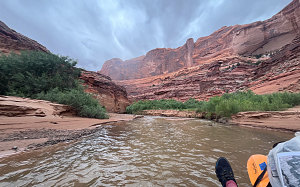
courtesy GBrancatelli
The stormy weather began to drift off by about 4:30pm, after which conditions became calm again - although a solid overcast remained. We were striving to make good distance today, and the cessation of obstacles on the river meant was helping us make good progress.
We soon rounded a corner where a series of seeps and springs on the right-hand (western wall) flowed down to the river. In places the overhang of the cliff above the river meant the spring's waters fell in a raindrop-like fashion. By the time I arrived, Gino and others had already stopped and were gathering a few bonus litres of fresh clean water. Never pass up a good spring!
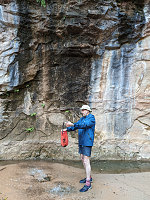
courtesy JInnes
6pm came and went, and still we forged on. The mood had turned towards finding a campsite, and so we started paying closer attention to the terrain alongside the river. It was especially brushy around here, and we continued for some time, passing a few marginal sites. I advocated for pushing on to something that was higher and less cramped.
As we neared Cow Canyon, a long and narrow section of elevated riverbank with a twenty-foot wide clear bench of hard damp sand came into view. It was by far the most promising site we had seen for some time, and given that the "find-camp" sentiment was getting stronger, we stopped and gave it a look. It was long and narrow, but would easily hold all of our tents and our rafts, and it was a good height (perhaps four or five feet) above the water level. The only drawback was a lack of privacy for the privy area, but we decided that a wall of stacked packrafts would make a suitable bathroom wall. Campsite chosen!
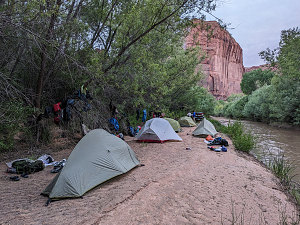
courtesy AWilcox
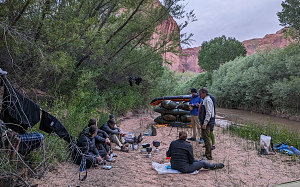
courtesy AWilcox
Everybody was moving perhaps a touch slower at camp this evening, for it had been a long day - nearly eleven hours on the water. We had had unfortunate mishaps - a flip or two; we had lost my gopro and all of its footage, and a few others had lost minor items (hats, gloves). On the plus side, we had managed to overachieve on the distance front, managing to cover 15 river miles (24km). In fact, our overall per-day average at the end of four days was now 12.1 miles, pretty much right on Gino's expected pace.
At the council meeting, Gino seemed fairly pleased. Talk of bail-out options and the unpleasant associated logistics had mostly fallen away. He was of course careful not to make it sound like the remainder of the trip was a cake-walk, but overall the sense was that we were now on-track for an as-planned, six-day trip with an exit out at Hole-in-the-Rock two days hence. Provided we didn't take our foot off the gas, so to speak.
Interactive trackmap with photo points - Packraft Day 4 - click map to view
River Day 4: Fools Canyon to Cow Canyon
Start Time:
8:17a.m.
End Time:
6:58p.m.
Duration:
10h41m
Distance:
24.28 km
(15.09 mi)
Average Speed:
2.3 km/hr
(1.4 mph)
Start Elevation:
3834ft
(1169m)
*
Max Elevation:
3834ft
(1169m)
*
Min Elevation:
3473ft
(1059m)
*
End Elevation:
3516ft
(1072m)
*
* : +/- 75 feet
Total Elevation Gain:
258ft
(79m)
*
Total Elevation Loss:
573ft
(175m)
*
* : +/- 75 feet
Elevation Graph